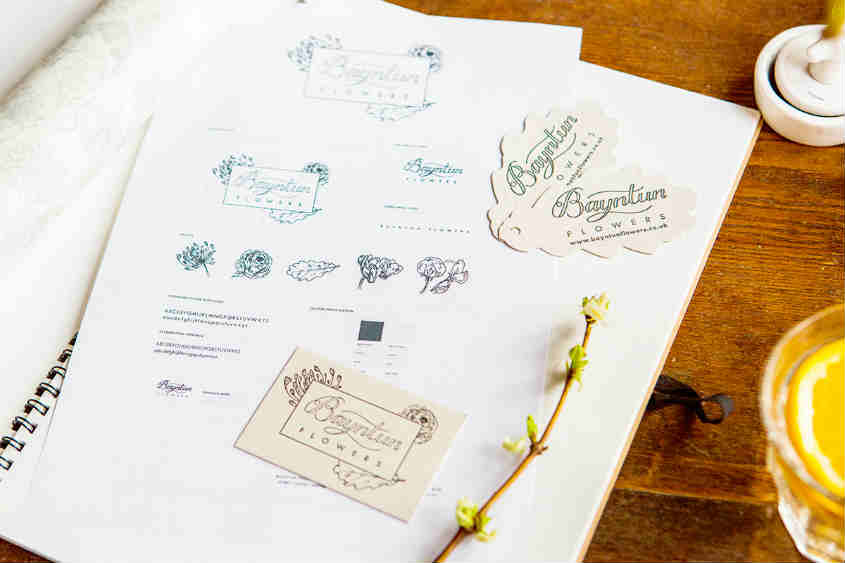
How to Style Your Brand Part 5: Reviewing creative work / Fiona Humberstone

Defining your vision… finding your focus… mood boards… the life-changing magic of colour psychology… we’ve covered so much over the past five weeks and here we have the final instalment of our How to Style Your Brand tutorial series. Over to Fiona.
Whether you’re designing your own brand or working with a professional, reviewing creative work is a skill that every business owner needs to master. This week we examine how to review creative work with confidence.
Tips for reviewing branding concepts
Constructive critique is an integral part of the design process. Handled thoughtfully and sensitively, it can be an inspirational and thoroughly rewarding exercise in ensuring that, as a designer, you produce your very best work.
And that’s why so many designers really relish client feedback: of course it’s about hearing that the job has been done well, but it’s also about gaining feedback to make sure that your identity really works for you.
I’ve been working in branding for 15 years now and have developed hundreds of brand identities for businesses around the world. And now that I’m consulting in a very different capacity, I see once again how many small business owners, who simply don’t do this sort of thing on a daily basis, need great advice.
Start with the big picture:
What message does this identity send out about your business? Ignore the fine detail for a moment and look at the big picture. Is it headed in the right direction?

Go back to the brief:
Does this achieve what you set out to? Does it reflect the vision you set originally?
Sometimes brand identities can go off on a tangent. Sometimes this can be a good thing: it can help you achieve things creatively that you never thought possible – and it’s one of the reasons that working with a talented designer or brand stylist can be so inspirational. But just make sure that it still sends out the message you originally hoped it would.
Go with your gut:
Trust that initial instinctive reaction you had when you first opened the email or viewed the presentation. How does the design make you feel?
Resist the temptation to micromanage:
It sounds obvious, but it’s worth bearing in mind that you don’t need to micromanage the design work; simply identify the elements that aren’t working for you and why. Let your designer work out the solution – that’s why you’re working with them!
Being too directive can often result in a design that just feels a bit wrong because, if you’re not careful, your designer will feel they just need to do ‘as they are told’, regardless of whether it’s the right decision or not.
What your designer really needs to understand is how the brand identity feels to you. They don’t need you to tell them which font to switch out or for you to give them all the answers: this is usually where things go wrong.
A strong and experienced designer will usually challenge you if they feel that your suggestions will have an adverse impact on the design, but they may not, and that’s often where things end up going a little awry.
Hone in on the details:
Look at every single detail: the way things line up and are balanced, the way your illustrations have been executed, the size of the font etc. Does it ‘work’? Your designer will have reviewed all of this before they sent it over to you, but you should also have a close look and check that you are comfortable with how everything fits together.
Again – no need to direct what they do if you’re not comfortable: better to ask questions or make suggestions. For example, “the icon feels too modern, how can we make it more timeless?” Rather than “can you use thinner lines and fewer corners?”. That way your designer is still creatively in control and you are allowing them to be at their best.

Print it out. Always!
Things always look different on paper to the way they do on screen.
Work as a team:
Your designer or brand stylist is a design expert, and no one knows your business better than you. Use this to your advantage and work as a team to create something that looks fabulous and reflects your business.
It (almost) goes without saying, but when you’re giving feedback, be warm, encouraging and specific. Explain what you love as well as the detail that you don’t and why.
Remember, your designer is on your side: they want to create something that you can both be proud of. As long as you both communicate openly and respect each others’ expertise, you’re on to a winner.
Underwhelmed?
Avoid getting personal or too emotional. Designers are creative beings and always work best when supported rather than put under pressure. Making them feel bad or telling them how disappointed you are isn’t going to help you get what you want, so take a deep breath, sleep on it and try and work out why it isn’t resonating with you.
Styling your brand should be a fun and inspirational process. It’ll help you build a stronger proposition, create something that wins you more work and build your confidence.
Do take a look at the other articles in this series for my guides as well as skipping on over to the brand stylist blog (external link)for more on styling your brand with flair.
This article was taken from my bestselling book How to Style Your Brand (external link) which is available now.
Great advice from Hiscox Business Insurance customer Fiona Humberstone. If you enjoyed this, check out the rest of the tutorial series:
How to style your brand Part 1: The absolute essentials
How to style your brand Part 2: Finding your focus
How to style your brand Part 3: Colour psychology – your secret weapon
How to style your brand Part 4: Creating a compelling vision
Disclaimer:
At Hiscox, we want to help your small business thrive. Our blog has many articles you may find relevant and useful as your business grows. But these articles aren’t professional advice. So, to find out more on a subject we cover here, please seek professional assistance.





